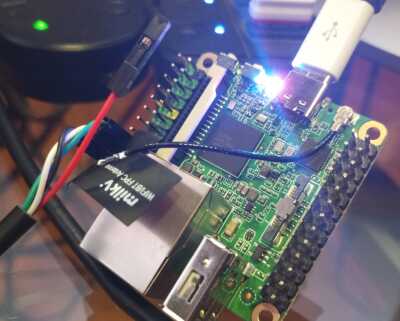A new RISC-V toy... requiring almost no tinkering
Shortly before coming back from Argentina, I got news of a very interesting set of little machines, the MilkV Duo. The specs looked really interesting and fun to play with, particularly those of the “bigger” model, Milk-V DUO S Some of the highlights:
- The SG2000
SoC
is a Dual-architecture beast. A hardware switch controls whether the CPU is an
ARM or a RISC-V.
- Not only that: It has a second (albeit lesser) RISC-V core that can run independently. They mention this computer can run simultaneously Linux and FreeRTOS!
- 512MB RAM
- Sweet form factor (4.2×4.2cm)
- Peeking around their Web site, it is one of the most open and well documented
computers in their hardware range.
- Schematics at different levels of detail
- Datasheet. It’s preliminary, and it’s written in Mandarin, but the information it contains is quite descriptive and clear.
- Full specifications (all 710 pages of it!) Again, it has a lot of Mandarin in it, but it conveys a lot of useful information.
Naturally, for close to only US$12 (plus shipping) for the configuration I wanted… I bought one, and got it delivered in early May. The little box sat on my desk for close to six weeks until I had time to start tinkering with it…
I must say I am surprised. Not only the little bugger delivers what it promises, but it is way more mature than what I expected: It can be used right away without much tinkering with! I mean, I have played with it for less than an hour by now, and I’ve even managed to get (almost) regular Debian working.
Milk-V distributes a simple, 58.9MB compressed Linux image, based on Buildroot, a simple Linux image generator mostly used for embedded applications, as well as its source tree. I thought that would be a good starting point to work on setting up a minimal Debian filesystem, as I did with the CuBox-i4Pro ten years ago, and maybe even to grow towards a more official solution, akin to what we currently have for the Raspberry Pi family…
…Until I discovered what looks like a friendly and very active online community of Milk-V users! I haven’t yet engaged in it, but I stumbled across a thread announcing the availability of Debian images for the Milk-V family.
And yes, it feels like a very normal Debian system. /etc/apt/sources.list does point to a third-party repository, but it’s for only four packages, all related to pinmux controlfor CVITEK chips. It does feel like a completely normal Debian system! It is not as snappy and fast to load as Buildroot, but given Debian’s generality, that’s completely as expected. Even the wireless network, one of the usual pain points, works just out of the box! The Debian images can be built or downloaded from this Git repository.
In case you wonder how is this system booting or what hardware it detects, I captured two boot logs:
